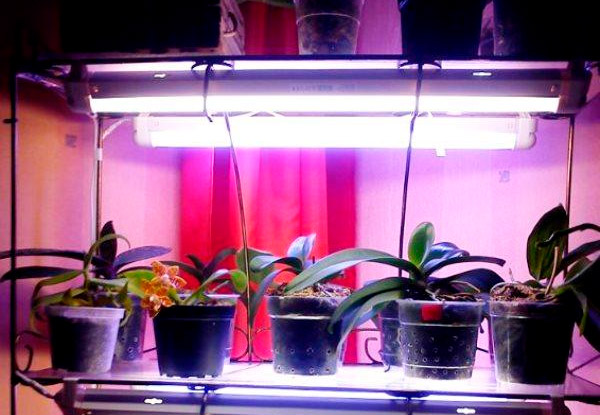Light for orchids
Last reviewed: 29.06.2025

Light is one of the most important factors when it comes to growing healthy orchids. It directly affects their ability to photosynthesize, bloom, and thrive. Orchids need light to survive, but understanding what kind of light is best for orchids and how much light they need is key to successful cultivation. In this article, we will cover all aspects of lighting, including how much light orchids need, what type of light is suitable, and how to create the ideal conditions for orchids at home.
Why do orchids need light?
Orchids need light for photosynthesis, the process by which they create food and energy for growth and flowering. Without sufficient light, orchids cannot produce the energy needed for healthy growth, leading to poor flowering and weak plants. Many people ask, does an orchid need light, and the answer is unequivocally yes. Orchids love light, but it must be the right type and amount.
How much light do orchids need? The amount of light required depends on the species of orchid. Some orchids, such as phalaenopsis, prefer medium light levels, while others, like cattleya and vanda, require bright light to thrive. On average, orchids need 10-12 hours of light per day. Orchids without enough light will often have dark green leaves, which indicates they are not receiving enough light for optimal growth.
What kind of light is best for orchids?
When it comes to what kind of light orchids need, the answer depends on the type of orchid and its natural habitat. Most orchids thrive under bright but indirect light. Direct sunlight can be too harsh and cause leaf burns, while too little light will result in slow growth and a lack of blooms. The key is to find a balance that mimics the conditions of their natural environment.
For indoor growing, it is important to understand what light is best for orchids at home. Orchids like bright, filtered light that comes from an east-facing or west-facing window. This provides gentle morning or late afternoon sunlight without the intensity of midday rays, which can scorch leaves.
Types of light: natural vs. Artificial
Natural light from the sun is ideal, but not always available in the right amounts. If you are wondering how much sunlight orchids need, keep in mind that they require bright but indirect light. For example, an east-facing window is often perfect because it provides gentle morning sun without overheating the plant.
Artificial light can be an excellent substitute or supplement for natural sunlight. Using Led grow lightsIs a popular solution for indoor growers, especially in climates with shorter days in winter. These lights provide a full spectrum of light for orchids, which is crucial for their health. When choosing artificial lights, ensure they provide both blue light, which promotes leaf growth, and red light, which stimulates flowering.

Do orchids need sunlight?
Do orchids need sunlight? Yes, they do, but orchids do not always need direct sunlight. Orchids like indirect light, which is similar to the dappled sunlight they receive under the canopy of trees in their natural habitats. If you place your orchid in direct sunlight, it may develop scorched or yellow leaves, indicating too much light exposure.
Another interesting aspect of light is orchids and moonlight. While orchids do not require moonlight for growth, many orchid enthusiasts find the beauty of orchids in moonlight to be enchanting. The moonlight enhances the delicate petals, making them appear ethereal in the soft glow.
Light requirements for orchid roots
The roots of orchids, especially epiphytic species like phalaenopsis, play a significant role in photosynthesis and the plant's overall vitality. This unique process is made possible by the presence of a specialized tissue layer called velamen, which not only absorbs moisture but also enables the roots to utilize light. Let’s explore why orchid roots need light, how to provide proper lighting, and common mistakes to avoid.
Why light is important for orchid roots
- Photosynthesis
In some orchid species, roots actively participate in photosynthesis thanks to velamen. This process provides additional energy for the plant, especially when leaves receive insufficient light.- Velamen's translucent structure allows light to reach chlorophyll layers.
- The greenish hue of roots indicates their photosynthetic activity.
- Overall plant health
- Light promotes healthy root development, supports active growth, and prevents rot.
- Transparent pots allow easy monitoring of root health, making it possible to detect issues like dehydration or rot early on.
What kind of light is suitable for orchid roots
- Natural light
Transparent pots allow sunlight to penetrate the roots, which is particularly important for epiphytic orchids.- Ideal conditions: diffused light from an eastern or western exposure.
- Caution: direct sunlight can overheat the roots and damage velamen.
- Artificial light
In conditions with insufficient natural light, especially during winter, artificial light sources can be used:- Grow lights: emit a spectrum optimal for photosynthesis without overheating the roots.
- Fluorescent lights: an economical option, but they should be positioned 20–30 cm (8–12 inches) away from the plant.
- Led lights: a modern solution with low energy consumption and customizable spectrums.
Rules for organizing light for orchid roots
- Transparent pots
- Use pots made of clear plastic to ensure light reaches the roots.
- Make sure the material is not colored, as tinted pots reduce light penetration.
- Diffuse lighting
- Protect the plant from direct sunlight using curtains or blinds.
- In low-light environments, place the orchid under artificial lighting.
- Duration of lighting
- Roots should receive light for 10–12 hours daily, mimicking natural daylight hours.
- During darker seasons, use timers for automatic light regulation.
Mistakes to avoid
- Excessive lighting
- Overly intense light can cause root burns, resulting in brown or dry patches.
- Improper pot selection
- Non-transparent or dense pots block light from reaching the roots, reducing their photosynthetic efficiency.
- Lack of ventilation
- Transparent pots without drainage holes can lead to waterlogging and root rot, even with good lighting.
How to provide light for orchids at home?
Providing the right light for orchids in home conditions involves finding the perfect balance between brightness and protection. Most orchids will do best in a location with filtered light from a window with a sheer curtain. If natural light is not sufficient, artificial lights can be used to supplement.
If you are unsure what light is needed for orchids, observe your plant's leaves. Healthy orchid leaves should be light green. If the leaves are dark green, this indicates insufficient light, while yellow or reddish leaves may mean the plant is getting too much light.
Light for orchids: sun or shade?
A common question among orchid growers is whether orchids need light or shade. The answer is that orchids need both—they require bright but indirect light. Too much direct sunlight can cause burns, while too much shade can hinder their growth. So, when asked do orchids prefer light or shade, it is important to understand the balance between the two.
Does an orchid like sunlight or shade? Orchids, especially phalaenopsis, tend to prefer bright but indirect light. Cattleya and vanda orchids, on the other hand, can tolerate more intense light. When considering light or shade for orchids, it's crucial to provide filtered light that allows them to thrive without damaging their delicate leaves.
Supportive light tools for orchids
To enhance light exposure for your orchids, you might consider using light stands for orchids or light supports. These devices can help position your orchids in such a way that they receive the optimal amount of light. You can also buy light stands for orchids from online stores specializing in orchid supplies.
When shopping for orchid light supports in an orchid light online store, look for stands that are adjustable and sturdy, ensuring your orchid gets consistent light throughout the day.
Conclusion
Orchids need light to thrive, but the right balance is key. If you’re wondering how much light orchids need, it depends on the species, but on average, they need 10-12 hours of bright, indirect light each day. Whether you grow your orchids using natural sunlight or artificial light for orchids, understanding their needs will help them grow healthier and bloom more beautifully.
If you have questions like how much light does a phalaenopsis orchid need, or does an orchid need sunlight, the answer is always about balance—orchids need bright light, but too much direct sunlight can be harmful. With the right care and attention to lighting conditions, your orchids can flourish and reward you with their stunning, exotic blooms.
